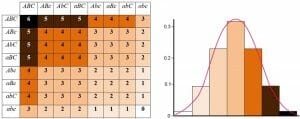Polygenic Inheritance Definition
Polygenic inheritance, also known as quantitative inheritance, refers to a single inherited phenotypic trait that is controlled by two or more different genes.
In a system which differs from Mendelian Genetics, where monogenic traits are determined by the different alleles of a single gene, polygenetic traits may display a range of possible phenotypes, determined by a number of different genes and the interactions between them.
The traits that are determined by polygenic inheritance are not simply an effect of dominance and recessivity, and do not exhibit complete dominance as in Mendelian Genetics, where one allele dominates or masks another. Instead, polygenic traits exhibit incomplete dominance so the phenotype displayed in offspring is a mixture of the phenotypes displayed in the parents. Each of the genes that contributes to a polygenic trait, has an equal influence and each of the alleles has an additive effect on the phenotype outcome.
Because of the inheritance mode patterns, the physical traits that are controlled by polygenic inheritance, such as hair color, height and skin color, as well as the non-visible traits such as blood pressure, intelligence, autism and longevity, occur on a continuous gradient, with many variations of quantifiable increments.
Polygenic inheritance should not be confused with the effects caused by multiple alleles. In the case of multiple alleles, a gene contains several different allele variants on the same locus of each chromosome, for example the three different alleles which control for blood type – A, B & O.
The probability of an offspring inheriting a certain characteristic from its parents can be determined using a punnet square, however, in reality there may be large numbers of different genes controlling for a single phenotype trait, so it becomes difficult to demonstrate. Fortunately, the distribution of phenotypes determined through polygenic inheritance usually fits into a normal distribution of probabilities, with most offspring displaying an intermediate phenotype of the two parents.
Using a simplified example of a polygenetic trait controlled by only three genes, this becomes easier to visualize.
Examples of Polygenic Inheritance
Skin Color
The pigment melanin is responsible for dark coloration in the skin and there are at least three genes, which control for human skin color. Using a hypothetical example where the production of melanin is controlled by contributing alleles (denoted here as A, B and C), resulting in dark skin color, and therefore light skin color is produced by non contributing alleles (denoted here as a, b and c), it is possible to see how the spectrum of different skin colors can result in the offspring.
It is important to remember here that in polygenic inheritance, alleles do not display dominance over others, rather, each contributing allele gives an additive effect rather than a masking effect, and so the way that the alleles interact is different to those in Mendelian genetics. The additive effect means that each contributing allele produces one unit of color.
In an example using two parents, heterozygous for each of the melanin-producing genes (AaBbCc x AaBbCc), it is possible to see how the additive effects and combinations of alleles results in all the possible genotypes.
In this simplified example, there are 64 possible allele combinations, which result in the production of 7 different colored skin tones.
The skin tones which are least likely to occur are those resulting from entirely homozygous genotypes. The lightest skin tone, 0 (aabbcc), which lacks any alleles contributing melanin pigment, or the darkest skin tone, 6 (AABBCC), which contains all possible contributing alleles; each of these phenotypes occurs at a probability of 1/64.
As the number of contributing alleles changes within the allele combinations, the units of melanin pigment increases and decreases; the probability of the second lightest or darkest skin tones (1 or 5) is 6/64, the third lightest or darkest skin tones (2 or 4), is 15/64 and an entirely intermediate skin tone (3) is the most common at 20/64. As shown in the histogram above, this pattern fits the normal distribution.
Human Height
Human height is an extremely complex inheritance pattern as there are over 400 genes controlling for it, it is therefore extremely difficult to predict the height that an offspring will be; two short parents may produce a tall child, whereas two tall parents can produce a short child and parents with completely different heights may produce a tall, short or intermediary child.
In addition, height is known as a multifactorial trait, which means that the trait is influenced by multiple genes as well as being affected by the environment. For example factors relating to general health of a growing child such as access to food and exposure to disease, could significantly affect the final height of a person. A large majority of our traits are multifactorial so it is often difficult to assess the effect that single genes have on a resulting phenotype
Related Biology Terms
- Mendelian Genetics – The set of theories proposed by Gregor Mendel, which attempt to explain the inheritance patterns of genetic characteristics based on simple breeding experiments involving single genes on chromosome pairs.
- Genotype – The genetic makeup of an individual organism.
- Phenotype – The physical and biological characteristics expressed in an individual as determined by their genotype.
- Epistasis – The interactions between separate genes, in which one masks the effect of another.
Quiz
1. In polygenic inheritance, traits are determined by:
A. Multiple alleles at a single locus
B. The interaction of multiple genes
C. Two dominant alleles on a gene
D. One gene being masked by another
2. How many different allele combinations can possibly be produced from two parents that are heterozygous for a polygenic trait controlled by three different genes with two allele pairs?
A. 5
B. 7
C. 54
D. 64
3. Which of the following phenotypes is unlikely to be a multifactorial trait affected by environment?
A. The risk of lung cancer
B. Down’s syndrome
C. High body Weight
D. Schizophrenia

